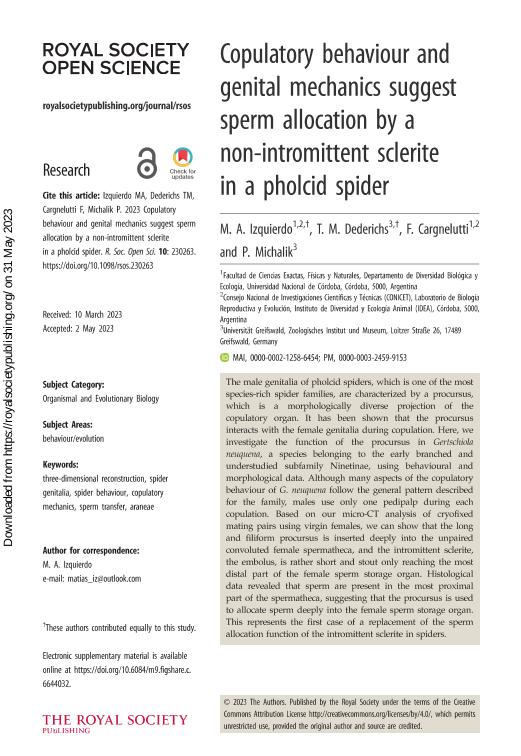Artículo
Copulatory behaviour and genital mechanics suggest sperm allocation by a non-intromittent sclerite in a pholcid spider
Fecha de publicación:
05/2023
Editorial:
The Royal Society
Revista:
Royal Society Open Sience
ISSN:
2054-5703
Idioma:
Inglés
Tipo de recurso:
Artículo publicado
Clasificación temática:
Resumen
The male genitalia of pholcid spiders, which is one of the most species-rich spider families, are characterized by a procursus, which is a morphologically diverse projection of thecopulatory organ. It has been shown that the procursus interacts with the female genitalia during copulation. Here, we investigate the function of the procursus in Gertschiola neuquena, a species belonging to the early branched and understudied subfamily Ninetinae, using behavioural andmorphological data. Although many aspects of the copulatory behaviour of G. neuquena follow the general pattern described for the family, males use only one pedipalp during each copulation. Based on our micro-CT analysis of cryofixed mating pairs using virgin females, we can show that the longand filiform procursus is inserted deeply into the unpaired convoluted female spermatheca, and the intromittent sclerite, the embolus, is rather short and stout only reaching the most distal part of the female sperm storage organ. Histological data revealed that sperm are present in the most proximalpart of the spermatheca, suggesting that the procursus is used to allocate sperm deeply into the female sperm storage organ. This represents the first case of a replacement of the spermallocation function of the intromittent sclerite in spiders.
Archivos asociados
Licencia
Identificadores
Colecciones
Articulos(IDEA)
Articulos de INSTITUTO DE DIVERSIDAD Y ECOLOGIA ANIMAL
Articulos de INSTITUTO DE DIVERSIDAD Y ECOLOGIA ANIMAL
Citación
Izquierdo, Matías Andres; Dederichs, Tim M.; Cargnelutti, Franco Ignacio; Michalik, Peter; Copulatory behaviour and genital mechanics suggest sperm allocation by a non-intromittent sclerite in a pholcid spider; The Royal Society; Royal Society Open Sience; 10; 5; 5-2023; 1-14
Compartir
Altmétricas




